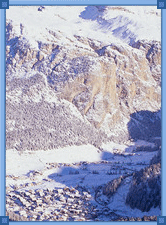Dolomite, which is named after is discoverer-a French mineralogist Deodat de Dolomieu, is a common sedimentary rock-forming mineral that can be found in massive beds several hundred feet thick. They are found all over the world and are quite common in sedimentary rock sequences. These rocks are called appropriately enough dolomite or dolomite limestone.
DOLOMITE is a double carbonate of calcium and magnesium, (CaMg(CO3)2). In other words, it contains 30.4% of CaO, 21.7% of MgO and 47.9% of CO2. However in nature there is variation in its composition. It is sedimentary origin and is supposed to have been formed due to alteration of Calcium Carbonate sediments or rocks, by sea-water rich in Magnesia.
Chemical Formula: CaCO3 MgCO3
Chemical Composition |
| Sr. no. |
Component |
Percentage |
| 1. |
CaCO3 |
53.6 |
| 2. |
MgCO3 |
42.0 |
| 3. |
CaO |
31.7 |
| 4. |
MgO |
20.5 |
| 5. |
Fe2O3 |
0.30 |
| 6. |
SiO2 |
5.50 |
| 7. |
Al2O3 |
0.50 |
|
| |
|
Characteristics of Dolomite
-
It has physical properties similar to those of the mineral calcite, but does not rapidly dissolve or effervesce (fizz) in dilute hydrochloric acid.
- Dolomite is also slightly harder, denser and never forms scalenohedrons (calcite's most typical habit).
-
Dolomite decomposes completely above 900ºC The product resulting from this relatively low-temperature calcination is highly porous and reactive and is known as 'calcinated dolomite'.
|
| |
|
Formation and Occurrence of Dolomite
 Dolomite is of sedimentary origin and is supposed to have been formed due to chemical action of sea-water containing high percentage of magnesia, on limestone. Dolomite is of sedimentary origin and is supposed to have been formed due to chemical action of sea-water containing high percentage of magnesia, on limestone.
Vast deposits are present in the geological record, but the mineral is relatively rare in modern environments. Dolomite accounts for about 10% of all sedimentary rock, including much that would have been produced near the surface of the Earth.
Disputes have arisen as to how these dolomite beds formed and the debate has been called the "Dolomite Problem". Dolomite at present time, does not form on the surface of the earth; yet massive layers of dolomite can be found in ancient rocks. Why no dolomite? Well there are no good simple answers.
It appears that dolomite rock is one of the few sedimentary rocks that undergoes a significant mineralogical change after it is deposited. They are originally deposited as calcite/aragonite rich limestone's, but during a process call diagnosis the calcite and/or aragonite is altered to dolomite. The process is not metamorphism, but something just short of that. Magnesium rich ground waters that have a significant amount of salinity are probably crucial and warm, tropical near ocean environments are probably the best source of dolomite formation.
Dolomite in addition to the sedimentary beds is also found in metamorphic marbles, hydrothermal veins and replacement deposits. Except in its pink, curved crystal habit dolomite is hard to distinguish from its second cousin, calcite. |
| |
Applications of Dolomite |
| |
 |
| |
|
|
|
 |